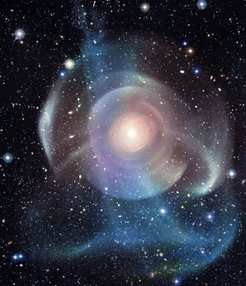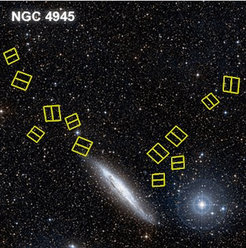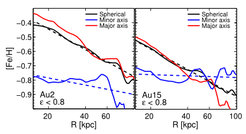The diversity of stellar halos in massive disk galaxies

Figure 1: The observed stellar halo of NGC 474 showing the complex substructure present in the outer regions of this large elliptical galaxy. Shells and tidal stellar streams are formed as a consequence of the interactions with and accretion of smaller galaxies.
Stellar halos are diffuse and faint components surrounding most large galaxies. They form largely from the accretion and disruption of smaller satellite galaxies, although their inner regions also contain stars which were formed in the disk of their host galaxy. Stellar halos are highly important to understand galaxy formation and evolution since they preserve a record of the accretion history of galaxies and serve as probes of the total matter distribution of galaxies. However, stellar halos are far less luminous than the main galactic disk. Observing them is therefore an extremely challenging task. Over the past decades, different approaches have been developed to reveal this diffuse component of galaxies. Observations of galaxies with very long exposure times have produced stunning images, an example of which is shown in Figure 1. These observations helped characterize the role of accretion and mergers in shaping the outskirts of galaxies as well as unveil their vast extent, reaching distances larger than 100 kpc from their centre.
To study the properties of stellar halos in detail, however, the astronomers need to observe their constituent stars. By doing so, it is possible to estimate the mean age and chemical composition (called metallicity, when all elements but hydrogen and helium are considered) of the halo stellar population as a function of distance from the galactic centre. Until recently, studies of halo stars were confined largely to our own Milky Way and the neighbouring Andromeda galaxy, due to the proximity of their stars. However, during the past years the GHOSTS survey has extended this study to nearby disk galaxies, thanks to the exquisite resolution of the Hubble Space Telescope (Figure 2).

Figure 2: Optical image of one of the galaxies in the GHOSTS sample, NGC 4945. Yellow squares indicate Hubble Space Telescope (HST) observations obtained in the stellar halo of this galaxy.
In her recent work, MPA scientist Antonela Monachesi has studied individual stars in the halos of nearby galaxies similar to the Milky Way using GHOSTS observations. This study showed that there is a great diversity in the metallicity of the observed stellar halos. In addition, the way this metallicity depends on the distance from the galactic centre also varies from galaxy to galaxy. In half the currently analyzed galactic halos the mean metallicity decreases with galactocentric distance, whereas the other half shows no significant variation with distance.
Moreover, the results from the GHOSTS observations showed that stellar halo properties differ greatly among galaxies that are otherwise alike in morphology, mass, and luminosity. The process of merger and accretion of satellites is rather stochastic and the properties of the stellar halos reflect the properties of the different accreted satellite galaxies.
The variety in the observed metallicity behaviour of stellar halos, with half galaxies presenting flat metallicity trends with distance, appeared to be at odds with previous results from hydrodynamical simulations, which had predicted large metallicity variations with distance as ubiquitous features. In order to investigate this seeming discrepancy, the research team at MPA used state-of-the art hydrodynamical cosmological simulations called “Auriga”. These simulations include the main physical processes responsible for the formation and evolution of galaxies in the universe and self-consistently follow the evolution of gas, stars and dark matter over time.

Figure 3: Metallicity trends of stellar halos as a function of galactocentric distance for two simulated galaxies using the Auriga simulations. This figure shows how the metallicity behaviour of stellar halos differs as a function of galactocentric distance if the metallicities are measured by averaging the properties of stars in concentric spherical shells (black), by projecting along a direction that is perpendicular to the galactic disk (blue), or on the disk plane (red). Dashed lines are linear fits to the black and blue lines to show trends more clearly. The blue lines are much flatter than the other two, showing that the metallicity variations will be much less, when averaging perpendicular to the disk – the method preferred by observations.
The MPA group analyzed the metallicity trends in stellar halos of simulated galaxies with similar mass and morphology as the Milky Way and the GHOSTS galaxies. As the main result, the scientists find from this analysis that the behaviour of the mean stellar halo metallicity with galactocentric distance depends strongly on the way it is measured. If the mean metallicities are derived by spherically averaging the properties of halo stars around the galactic center, as done in previous simulations, large variations in the mean metallicity with distance are obtained. However, if the mean metallicities are derived along a direction that is perpendicular to the galactic disk, the metallicity tends to be much more uniform (Figure 3). In observational studies, the latter direction is preferred since it allows the scientists to minimize contamination from galactic disk stars. The MPA group has thus clearly highlighted the crucial importance of preforming careful comparisons between models and observations of halo metallicity distributions. This is the only way to alleviate tension between theory and observations.
In future work, the MPA group will perform a very careful and detailed analysis of the simulations to compare against observations and to interpret the observations. This will allow them to decipher the accretion history of the GHOSTS galaxies.
Antonela Monachesi, Facundo Gomez and Guinevere Kauffmann














